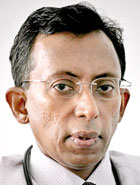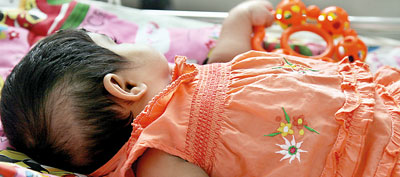Special dengue unit at Negombo
Marking a first in the world, a 17-bed state-of-the-art centre geared to manage both adults and children.
Snuggling up to her mother, cherubic baby Ishani* is fast asleep, smiling contentedly in the world of dreams. Although she is oblivious to the harsh reality that just 10 days ago she had a tryst with death, her mother is acutely aware how close the near-miss was.
Other little ones among the 50 men, women and children who form the dengue death data for the first six months of this year across the country have not been fortunate in their battle against a disease waged by a tiny mosquito.

Dr. LakKumar Fernando
For Ishani, the deciding factor between life and death was that she was in the right place though not really at the right time. The place was none other than the not officially-opened ‘Centre for Clinical Management of Dengue and Dengue Haemorrhagic Fever’ at the Negombo General Hospital which has been on a trial-run since June 10.
The trial-run, while awaiting the official opening, has already seen 34 patients, both adults and children, passing through or walking out from the centre after having been brought critically-ill and near-death. The 17-bed state-of-the-art centre is unique as it is geared to manage both adults and children, acclaimed as a first by many.
All “vitals” such as blood pressure, heart rate, oxygen saturation and temperature of patients accommodated here are monitored by individual machines attached to each bed while infusion pumps will combat fluid leakage after accurate electronic calculation of individual needs, critical in the management of Dengue Haemorrhagic Fever (DHF) cases.
Ishani’s “management” before being brought to the centre is sickeningly similar to many across the country. Living at Seeduwa, this six-month-old baby was gripped by fever on June 17 and her vigilant parents took her faithfully to a General Practitioner (GP) in the area whom they trust. There was no mention of dengue by the GP who without batting an eyelid prescribed Brufen to bring the fever down. When even three days later (by June 19) the paracetamol and Brufen had not brought the fever down, the distraught parents went back to the main GP in the same private clinic, only to be re-prescribed Brufen. By the next day (June 20), the situation of the baby was serious.
“She was very ill,” whispers the mother, explaining that her baby was moaning. Usually active, she was not able to even raise her hands or legs. They then took her to the GP again in the morning and suggested that a blood test should be done, but the doctor did not see the need. By evening her condition had deteriorated and it was then that a blood test and on the recommendation of others a Dengue NS1 Antigen Test were performed, with the results coming out clearly ‘Positive’.

Baby Ishani snatched from a tryst with death. Pix by M.A. Pushpa Kumara
Thereafter, the parents quickly brought the little one to the Negombo Hospital, where she was admitted to Paediatric Ward 8A of Consultant Paediatrician and dengue expert Dr. LakKumar Fernando around 11.30 on the night of June 20.
Critical was the baby’s condition, the Sunday Times understands. The ward doctors had on their hands a tiny, badly dehydrated dengue victim whose blood pressure was plummeting, pulse was very weak and heart rate feeble at 180 beats per minute. Her platelet count had dropped to 27,000 (it would later come down further to 6,000) and she was in severe liver failure, with liver enzymes 100 times higher than normal.
The fight for her life had begun in the ward with preliminary treatment seeing the administration of a fluid bolus, before she was rushed to the centre. With the portable modern ultrasound scan at the centre showing clearly that fluid had leaked not only into her abdomen but also lungs, it was a deadly race to prevent shock setting in and the baby slipping away.
With indications that they were dealing with the double jeopardy of “leaking and bleeding” as otherwise the fluid bolus would have helped stabilise the baby, blood transfusions had been essential. Needing to monitor urine output, the next issue had been the insertion of a catheter, with adhesions making it an extremely difficult task. A young doctor, however, had overcome all challenges in the first go, where many other attempts had failed, the Sunday Times learns.
For the skeleton staff of both doctors and nurses fighting against heavy odds to save Ishani under the guidance of Dr. Fernando it was a long, exhausting and unforgettable night. It was also not only Ishani they had to manage that night but many others including an 18-year-old who was on the brink of death.
As Ishani is taken home from hospital by her overjoyed parents, it is “all part of the job” for the team. “Seeing our critically-ill patients leave the centre after overcoming deadly DHF is our job satisfaction,” smiles a young doctor, speaking for the dedicated team.
(*Name changed to protect identity)
Follow @timesonlinelk
comments powered by Disqus


